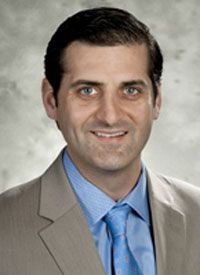Multidisciplinary Approach to Radium-223 Treatment Favored for Metastatic Prostate Cancer
Radium-223 dichloride (Xofigo) has shown a significant survival advantage in the treatment of patients with metastatic castration-resistant prostate cancer (mCRPC) who have symptomatic bone metastases, and a multidisciplinary approach to treatment has become more widely practiced in community clinics.
Joseph F. Renzulli, II, MD

Joseph F. Renzulli, II, MD
Radium-223 dichloride (Xofigo) has shown a significant survival advantage in the treatment of patients with metastatic castration-resistant prostate cancer (mCRPC) who have symptomatic bone metastases, and a multidisciplinary approach to treatment has become more widely practiced in community clinics.
“It is important that all of the disciplinesradiation oncology, medical oncology, and urology—work as a team to address the problem,” said Joseph F. Renzulli, II, MD, director of prostate surgery, Miriam Hospital, Adult Urology, and assistant professor of surgery (urology) at Alpert Medical School of Brown University, in an interview withTargeted Oncology. He is also the lead author of a paper published in theJournal of Multidisciplinary Healthcaretitled, “Radium-223 dichloride: illustrating the benefits of a multidisciplinary approach for patients with metastatic castration-resistant prostate cancer.”
He and his colleagues chose radium-223 because it is the only radionucleotide with an OS advantage, while others are more palliative, said Renzulli. He also stresses the importance of distinguishing between them, as there are many different treatments for mCRPC.
According to Renzulli there is not one specialty that is able to solely administer the radium-223, because administration requires referral to a radiation oncologist or nuclear medicine practitioner from an oncologist or urologist. The process requires a dual interaction, or possible a tri-interaction, between specialties, in order to successfully integrate radium-223 into practice and to work toward a successful outcome for patients.
If solo practitioners want to incorporate a multidisciplinary approach, Renzulli suggests that they team up with a radiation oncologist and/or a nuclear medicine physician and create a protocol for patients who may be candidates for radium-223, and then decide how to manage this protocol.
“I think we need to move away from the constant dogma of multidisciplinaryit doesn’t have to be a ‘true’ multidisciplinary center where patients are seen by all three doctors at once, but rather it should be a collaborative effort where the doctors have created an arrangement where there are going to be multiple doctors caring for the patient in the advanced prostate cancer setting,” said Renzulli. Although in his clinic, patients see all three doctors at once and at the same time, he notes that this practice is not feasible in many models.
If a multidisciplinary approach is used, Renzulli feels the ideal clinicians would be urology, radiation oncology, and medical oncology.
In terms of sequencing treatments, Renzulli and his team have started to no longer use oral therapies back-to-back, due to the cross resistance. If a patient is on an oral therapy, such as abiraterone and prednisone, and the treatment starts to fail, then Renzulli and his team would use chemotherapy or radium-223 before going back to an oral therapy; if there is a nice response, the patient may go back to enzalutamide.
In light of the STAMPEDE trial and the CHAARTED data, urologists have to be comfortable treating with chemotherapy for metastatic prostate cancer, according to Renzulli. He does not think that they have to be the ones administering the chemotherapy, but rather that they need to coordinate care in a multidisciplinary fashion with an oncologist who they feel they can provide that service to their patients safely and effectively. “I think that is of paramount importance now in prostate cancer,” commented Renzulli.
Radium-223 is a novel therapy for patients who have mCRPC because it can provide them with a survival advantage, according to Renzulli. He concludes that it is best to coordinate the care between the urologist, as well as the radiation and medical oncologists, to ensure the patient completes the therapy and avoids issues that may arise, which could interfere with completing 6 full cycles of treatment.